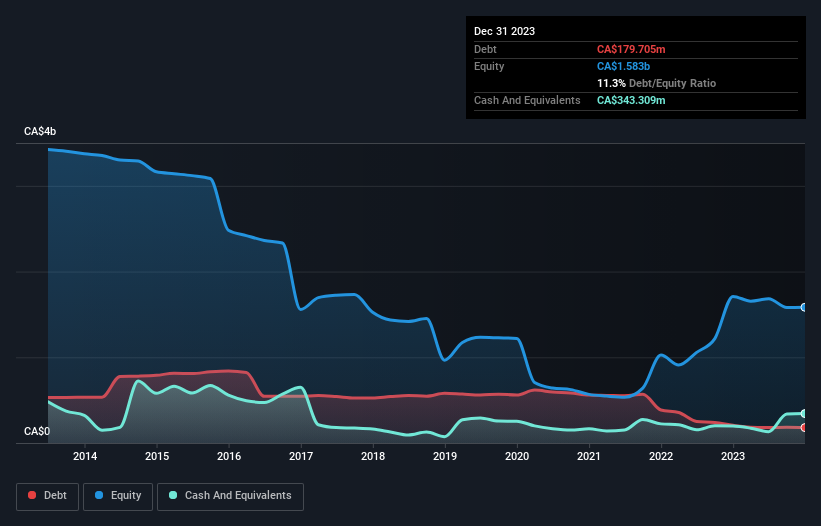Some say volatility, rather than debt, is the best way to think about risk as an investor, but Warren Buffett famously said that 'Volatility is far from synonymous with risk.' It's only natural to consider a company's balance sheet when you examine how risky it is, since debt is often involved when a business collapses. We can see that Athabasca Oil Corporation (TSE:ATH) does use debt in its business. But is this debt a concern to shareholders?
When Is Debt Dangerous?
Debt assists a business until the business has trouble paying it off, either with new capital or with free cash flow. In the worst case scenario, a company can go bankrupt if it cannot pay its creditors. However, a more usual (but still expensive) situation is where a company must dilute shareholders at a cheap share price simply to get debt under control. Of course, debt can be an important tool in businesses, particularly capital heavy businesses. The first step when considering a company's debt levels is to consider its cash and debt together.
Check out our latest analysis for Athabasca Oil
What Is Athabasca Oil's Net Debt?
You can click the graphic below for the historical numbers, but it shows that Athabasca Oil had CA$179.7m of debt in December 2023, down from CA$206.1m, one year before. However, it does have CA$343.3m in cash offsetting this, leading to net cash of CA$163.6m.

How Healthy Is Athabasca Oil's Balance Sheet?
Zooming in on the latest balance sheet data, we can see that Athabasca Oil had liabilities of CA$185.1m due within 12 months and liabilities of CA$280.1m due beyond that. On the other hand, it had cash of CA$343.3m and CA$100.1m worth of receivables due within a year. So it has liabilities totalling CA$21.8m more than its cash and near-term receivables, combined.
Having regard to Athabasca Oil's size, it seems that its liquid assets are well balanced with its total liabilities. So it's very unlikely that the CA$2.81b company is short on cash, but still worth keeping an eye on the balance sheet. While it does have liabilities worth noting, Athabasca Oil also has more cash than debt, so we're pretty confident it can manage its debt safely.
While Athabasca Oil doesn't seem to have gained much on the EBIT line, at least earnings remain stable for now. The balance sheet is clearly the area to focus on when you are analysing debt. But ultimately the future profitability of the business will decide if Athabasca Oil can strengthen its balance sheet over time. So if you want to see what the professionals think, you might find this free report on analyst profit forecasts to be interesting.
But our final consideration is also important, because a company cannot pay debt with paper profits; it needs cold hard cash. While Athabasca Oil has net cash on its balance sheet, it's still worth taking a look at its ability to convert earnings before interest and tax (EBIT) to free cash flow, to help us understand how quickly it is building (or eroding) that cash balance. During the last three years, Athabasca Oil generated free cash flow amounting to a very robust 89% of its EBIT, more than we'd expect. That positions it well to pay down debt if desirable to do so.
Summing Up
We could understand if investors are concerned about Athabasca Oil's liabilities, but we can be reassured by the fact it has has net cash of CA$163.6m. The cherry on top was that in converted 89% of that EBIT to free cash flow, bringing in CA$166m. So we don't think Athabasca Oil's use of debt is risky. Of course, we wouldn't say no to the extra confidence that we'd gain if we knew that Athabasca Oil insiders have been buying shares: if you're on the same wavelength, you can find out if insiders are buying by clicking this link.
If, after all that, you're more interested in a fast growing company with a rock-solid balance sheet, then check out our list of net cash growth stocks without delay.
New: Manage All Your Stock Portfolios in One Place
We've created the ultimate portfolio companion for stock investors, and it's free.
• Connect an unlimited number of Portfolios and see your total in one currency
• Be alerted to new Warning Signs or Risks via email or mobile
• Track the Fair Value of your stocks
Have feedback on this article? Concerned about the content? Get in touch with us directly. Alternatively, email editorial-team (at) simplywallst.com.
This article by Simply Wall St is general in nature. We provide commentary based on historical data and analyst forecasts only using an unbiased methodology and our articles are not intended to be financial advice. It does not constitute a recommendation to buy or sell any stock, and does not take account of your objectives, or your financial situation. We aim to bring you long-term focused analysis driven by fundamental data. Note that our analysis may not factor in the latest price-sensitive company announcements or qualitative material. Simply Wall St has no position in any stocks mentioned.
About TSX:ATH
Athabasca Oil
Engages in the exploration, development, and production of thermal and light oil resource plays in the Western Canadian Sedimentary Basin in Alberta, Canada.
Flawless balance sheet with solid track record.
Similar Companies
Market Insights
Community Narratives


Recently Updated Narratives

TAV Havalimanlari Holding will fly high with 25.68% revenue growth


Fiducian: Compliance Clouds or Value Opportunity?


Q3 Outlook modestly optimistic
Popular Narratives


MicroVision will explode future revenue by 380.37% with a vision towards success


The company that turned a verb into a global necessity and basically runs the modern internet, digital ads, smartphones, maps, and AI.



